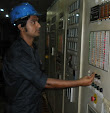The effect of charge air condensate on Diesel Engine
The effect of charge air
condensate on Diesel Engine is massive. The formation of charge air condensate
depends upon many factors. The relative humidity of the air and cooling system
(CHATCO) play an important role for condensation. If the formation of charge
air condensation is not controlled properly, it creates huge impacts on engine.
Let’s discuss.
Cold corrosion inside combustion chamber
Fuel (Heavy fuel oil) contains Sulphur. Charge air contains
water in vaporized form. During engine stopped condition, as the combustion
chamber temperate goes down (below dew point temperature), water forms as a
film onto the component's surface of as aerosols.
 |
| Corrosion inside combustion chamber due to condensation |
This water combines with sulphur and form sulphuric acid, which causes cold corrosion in the combustion chamber components (Cylinder liner, piston crown, cylinder head, exhaust- inlet valves & seats.
Channel on Inlet valve and
valve seat sealing area
Due to the acid formation in the inlet valve and valve
sealing surface, corrosion started and the material properties changed (getting
weak). Experience shows that the sulfuric acid corrodes the softer phases of
the cast iron at a faster rate.
 |
| valve and valve seat damaged due to charge air condensation |
During suction stroke charge air (saturated
with fine water particle) and condensate entered through the sealing surface
which acts as jet and damaged the weak area. As the sealing surface starting
damaged, exhaust gas also damaged the surface.
Torched valve sealing surfaces showed metal loss, surface
cracking, and oxidation. Non torched areas retained a compacted oil deposit
covering an oxidized sealing surface.
Intake manifold corrosion
High condensate in the charge air causes
corrosion (rust formation) in the intake air manifold. Charge air strike at the
wall and the end cover and goes to liquid form. Not all condensate drained at a
time. Some go to combustion chamber and some stayed in the bottom of the charge
air manifold which cause corrosion.
 |
| Corrosion inside charge air manifold due to condensate |
Charge air cooler corrosion
 |
| Rusty Charge Air Cooler due to Condensate |
High exhaust temperature
High fuel consumption
Charge air contains moisture,
which reduces combustion speed.
Combustion efficiency is always
higher at low condensate in charge air. This has a positive relationship with
fuel consumption and negative relationships with combustion efficiency.
Conclusion: humidity as low as
possible for better fuel consumption and higher efficiency









Thank you for sharing this information about the effect of charge air condensate on Diesel Engine.
ReplyDeleteDiesel fuel suppliers in UAE
قمر الامارت
ReplyDeleteشركة تنظيف مطابخ وازالة الدهون فى الفجيرة
شركة تنظيف فلل فى الفجيرة
Thanks for sharing an informative blog on the effect of charge air condensate on Diesel Engine, Really enjoyed reading it.
ReplyDeleteAutomatic Batch Blending (ABB)
Nice articles and your information valuable and good articles thank for the sharing information AUTOMATIC BATCH BLENDING SYSTEM
ReplyDeletePlease look here at 2ufuel.com.
ReplyDeleteijny49b23
ReplyDeletegolden goose outlet
golden goose outlet
golden goose outlet
golden goose outlet
golden goose outlet
golden goose outlet
golden goose outlet
golden goose outlet
golden goose outlet
golden goose outlet